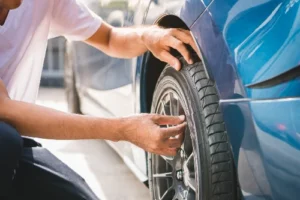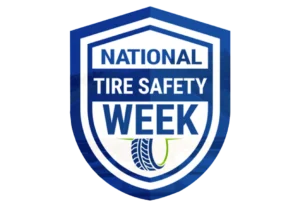National Tire Safety Week in Yorba Linda is approaching, and to celebrate, we would like to go over some of the most critical components of tires and why it’s so vital to have the correct tires for your vehicle. Tires have come a long way in terms of innovation and development to improve efficiency and effectiveness on the road. There are various factors that go into determining what makes a good tire and ensuring that the tires are properly maintained.
In Yorba Linda, California, this week is a prime opportunity for drivers to ensure their vehicles are road-ready. Yorba Linda Auto Service is committed to helping you understand and practice tire safety, providing expert advice and services to keep you and your loved ones safe on the road.

Tire Inspection for Safety
Why Tire Safety Matters
Tires are the only part of your vehicle that touches the road. This makes them crucial for the safety and efficiency of your car. Properly maintained tires enhance your vehicle’s performance, improve fuel efficiency, and most importantly, keep you safe. During National Tire Safety Week, it’s essential to focus on tire care to prevent accidents and extend the lifespan of your tires.
Key Aspects of Tire Safety
- Tire Dimensions
It is critical to select the correct tire size for your vehicle. The correct size is usually stamped on the tire’s sidewall and is expressed in a series of numbers and characters, such as 245/60R16. The first digits represent the tire’s width, while the numbers after the dash represent the aspect ratio or the sidewall as a percentage of the width. With sportier vehicles running 30-40 and SUVs 45-60, the smaller the number, the smaller the sidewall. The next letter, in this case, R, denotes the type of construction, which in this case is a radial tire. The last digit denotes the rim size that fits within the tire.
- Tire Pressure
Checking your tire pressure is simple and inexpensive, and it can help you avoid a traffic accident. Digital pressure gauges, dial pressure gauges, and pen-type pressure gauges are three different ways to measure your PSI or pounds per square inch. The suggested pressure is usually around 30-35 PSI, although the manufacturer’s guideline should be checked in the owner’s manual. - Tire Trims
Tire trims are divided into four categories: directional, symmetrical, asymmetrical, and directional/asymmetrical. Directional thread is designed to move in only one direction and has grooves that channel water out of the way to prevent hydroplaning. Hydroplaning is the loss of steering and braking control caused by a thin layer of water between the tire’s surface and the ground. Symmetrical thread comprises symmetrical grooves and is most commonly found on non-high-performance automobiles since the tire runs smoother and lasts longer. Because it combines a variety of groves to offer maximum grip for better handling and control, asymmetrical threads are most typically utilized in high-performance automobiles. Directional/asymmetrical tread tires combine two threads by including a v-shape pattern that provides excellent handling and control while still repelling water.
- Types of Tires
It’s also crucial to figure out what kind of tires you’ll need for your vehicle. Summer tires, winter tires, and all-season tires are among the classifications. In hotter climates, summer tires perform well in both dry and wet conditions. In colder climates, however, winter tires are better suited for snow and ice. Summer and winter tire properties are combined in all-season tires. Despite the fact that all-season tires have some winter qualities, it is nevertheless suggested to use certified winter tires in worse conditions.
Tips for Year-Round Tire Maintenance
Yorba Linda Auto Service is your local expert in tire maintenance and safety. Our team is dedicated to providing top-notch services, including tire inspections, rotations, and replacements. We understand the unique driving conditions in Yorba Linda and tailor our services to meet the needs of our community.
- Regular Inspections
Regularly inspect your tires for signs of wear and damage. Look for any cuts, punctures, or unusual wear patterns that might indicate a problem. - Keep Tires Clean
Keeping your tires clean can help prevent the buildup of debris and corrosive substances that can damage the rubber. Use a mild soap and water to clean your tires regularly. - Avoid Overloading
Overloading your vehicle can put excessive stress on your tires, leading to increased wear and the potential for blowouts. Always adhere to the load limits specified in your vehicle’s manual. - Monitor Driving Habits
Aggressive driving, such as rapid acceleration and hard braking, can cause your tires to wear out faster. Adopt a smoother driving style to extend the life of your tires.
Celebrating National Tire Safety Week in Yorba Linda Auto Service
 National Tire Safety Week is an excellent reminder to take care of your tires and ensure your vehicle is safe for the road. At Yorba Linda Auto Service, we are committed to providing you with the best tire maintenance services and educating you on the importance of tire safety. Celebrate National Tire Safety Week with us and take advantage of our free inspections, discounts, and educational workshops. Your safety is our priority, and we are here to help you keep your tires in top condition year-round.
National Tire Safety Week is an excellent reminder to take care of your tires and ensure your vehicle is safe for the road. At Yorba Linda Auto Service, we are committed to providing you with the best tire maintenance services and educating you on the importance of tire safety. Celebrate National Tire Safety Week with us and take advantage of our free inspections, discounts, and educational workshops. Your safety is our priority, and we are here to help you keep your tires in top condition year-round.
As we approach summer vacations and road trips, it’s critical to remember the importance of keeping your tires in good repair. This National Tire Safety Week, Yorba Linda Auto Service would like to remind you to prioritize your vehicle’s safety and stop by for any needed service. Visit us at 801 S Lakeview Avenue, Unit G, Placentia, CA 92870 or click here to schedule an appointment. Lastly, don’t forget to visit us on our Facebook page!












[…] Keep a small trash bag in your vehicle to prevent clutter buildup. Empty it regularly to maintain a clean…